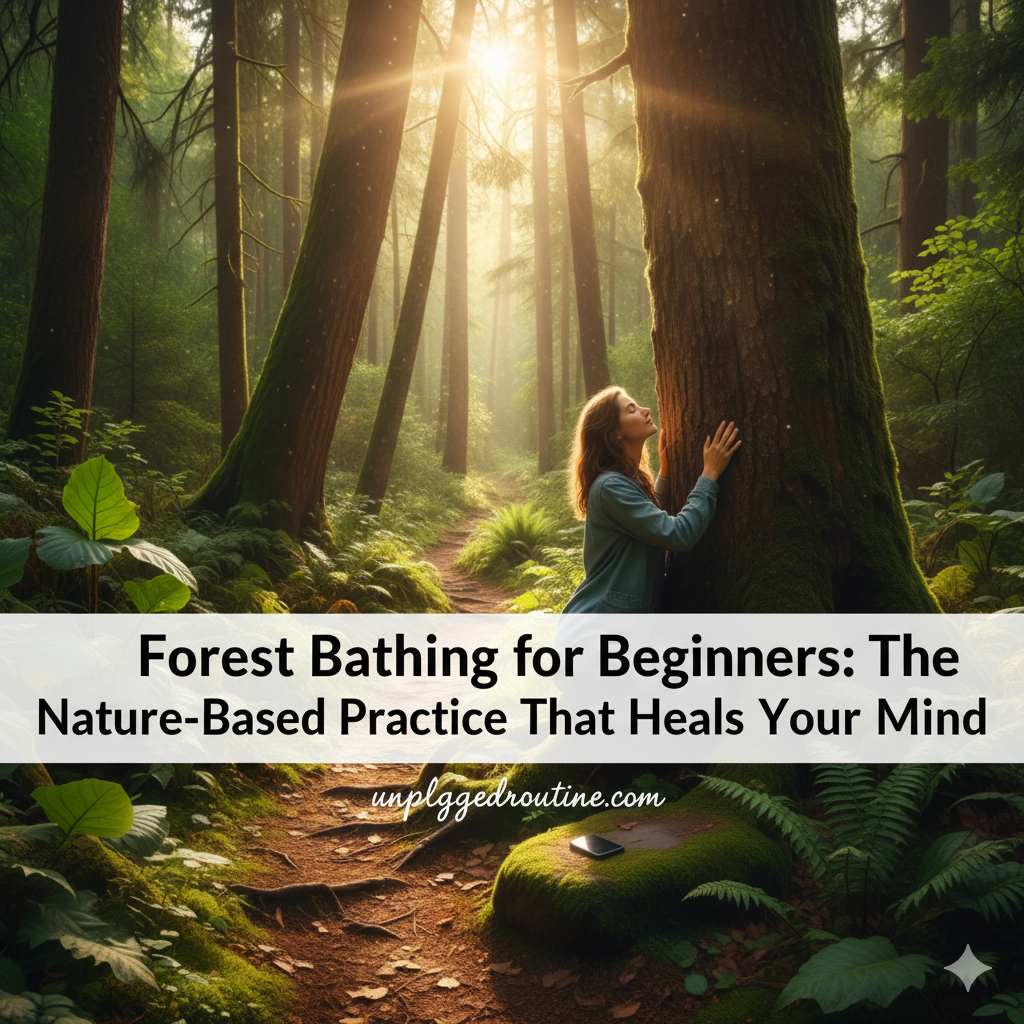Feeling overwhelmed by concrete walls, glowing screens, and the never-ending hustle? Is your nervous system constantly stuck in high-alert mode? We all intuitively know that spending time in nature is good for us, but what if there was a simple, structured practice that could transform a casual walk into a powerful mental and physical healing session?
Enter Forest Bathing, or Shinrin-Yoku (as it’s known in Japan, where the practice originated). This isn’t about swimming or hiking; it’s about mindfully immersing yourself in the atmosphere of the forest. It is slow, intentional, and scientifically proven to be a profound antidote to modern-day stress. It’s an easy, accessible way to integrate an unplugged routine into your life.
Ready to discover how just an hour among the trees can lower your blood pressure, reduce stress hormones, and boost your immune system? This beginner’s guide is your ticket to nature’s healing power.

What Exactly is Forest Bathing? (And Why It’s Not Just a Walk)
Forest Bathing is the deliberate, mindful practice of spending time in a forested environment to promote health and well-being. The key words here are deliberate and mindful.
Unlike a typical hike where the goal is distance, speed, or reaching a summit, the goal of Forest Bathing is presence. You engage all five senses to absorb the forest atmosphere. Think of it as meditation in motion, guided by the sights, sounds, and smells of the woods.
This practice is an essential component of an unplugged routine because it forces you to set down your phone, abandon your to-do list, and tune into the natural world instead of the digital one.
The Scientific Power of Trees: Healing Benefits You Can’t Ignore
The incredible healing effects of Forest Bathing aren’t just anecdotal—they’re backed by decades of compelling research, particularly from Japan and South Korea, where the practice is a cornerstone of preventative medicine.
- Stress Reduction: Studies consistently show that time spent Shinrin-Yoku-style lowers levels of cortisol, the primary stress hormone.
- Lowered Blood Pressure: The calming environment naturally encourages your heart rate and blood pressure to decrease.
- Immune System Boost: Trees emit aromatic compounds called phytoncides (essential oils like terpenes). When we breathe them in, they have been shown to increase the number and activity of natural killer (NK) cells, a type of white blood cell that fights infections and tumor cells. Nature is literally medicine!
- Improved Mood and Focus: Exposure to forest environments is linked to a decrease in anxiety, depression, and confusion, while boosting creativity and mental clarity.
- Better Sleep: By regulating your nervous system and reducing stress, Forest Bathing can significantly improve the quality and duration of your sleep.

Your 7-Step Beginner’s Guide to a Healing Forest Bath
You don’t need special equipment or a massive forest reserve. You can start this practice in a local park with just a few trees. Here is the step-by-step process for your first transformative Forest Bathing session.
Step 1: Set Your Intention (The First 5 Minutes)
Before you even step into the trees, commit to leaving your digital life behind.
- Power Down: Turn your phone completely off or set it to airplane mode. This is non-negotiable.
- Slow Down: Commit to moving slowly, without a destination or a time goal. Aim for 90 minutes to two hours, but let go of the clock.
- Choose Comfort: Wear comfortable shoes and clothing. Bring water, but nothing else that will distract you.
Step 2: The Gateway Invitation – Tune into Sound
Find a comfortable spot near the entrance of your chosen natural area. Close your eyes and spend several minutes focusing only on sound.
- Listen past the sounds of traffic or distant voices. What do you hear closer to you?
- The rustling of leaves? The chirping of birds? The wind moving through the branches?
- Listen without judgment. Just notice the acoustic environment of the forest.
Step 3: The Slow Stroll – Mindful Movement
Begin to walk, but at about half your normal pace. This is not exercise; it’s an invitation to notice.
- Focus on your feet: Feel the texture of the ground beneath your shoes—is it soft dirt, gravel, or smooth moss?
- Look closely: Examine the texture of bark, the patterns on moss, the tiny insects in your path. Stop whenever something catches your eye. There is no rush.
Step 4: The Olfactory Immersion – Inhale the Forest
This step harnesses the power of those healing phytoncides. Stop and take five deep, slow breaths.
- Inhale deeply through your nose, filling your lungs with the forest air.
- What do you smell? Pine? Damp earth? Fallen leaves? Wildflowers?
- The smell of the forest is the scent of nature’s medicine. Acknowledge and appreciate this natural aromatherapy.
Step 5: The Tactile Connection – Use Your Hands
Our sense of touch is often neglected in our digital lives, but it is a powerful way to ground us in the present.
- Gently touch the bark of a tree. How does it feel? Rough, smooth, wet, or dry?
- Hold a leaf or a small stone in your hand. Feel its temperature and shape.
- Dangle your fingers in a stream or let them brush against the tips of pine needles. This tactile engagement deepens your sense of connection.
Step 6: Finding a “Sit Spot” – Deep Rest
After an hour or so of wandering, find a spot that invites you to rest. It should be a place where you feel comfortable and secure.
- Sit down (on a log, a rock, or a small blanket) and remain still for at least 15–20 minutes.
- Let your eyes softly gaze at the canopy or a vista.
- Simply be in the presence of the forest. This is often where the deepest relaxation and emotional release occur.
Step 7: The Closing Circle – Taking the Forest with You
Before you leave the environment, take a moment to reflect on your experience.
- What feeling or insight did the forest offer you?
- Express gratitude for the space and the trees.
- Choose one natural object (a small smooth stone, a fallen acorn, a mental image) to take with you as a physical reminder of the calm you found.
Troubleshooting Your Forest Bathing Session
- “I don’t have a forest.” Don’t worry! Any green space works: a local park, a community garden, a tree-lined street, or even a large backyard. The practice is more about the mindset than the location.
- “I feel awkward doing this.” That’s normal! This practice is counter-cultural to our rushed lives. Just remember: you are healing yourself. No one is watching, and if they are, they’re probably wishing they were doing it too.
- “My mind keeps wandering.” The goal isn’t to stop thinking. The goal is to gently redirect your attention back to your senses—the sights, sounds, smells, and textures of the forest—every time your mind drifts. That redirection is the meditation.
Forest Bathing: The Ultimate Unplugged Routine
By adding Forest Bathing to your life, you are choosing intentional connection over accidental distraction. You are creating a powerful digital boundary and giving your body and mind the ancient, primal medicine they crave. This is not just a trend; it’s a foundational practice for mental health in the 21st century.
Make a commitment to this self-care ritual. Treat it like a crucial, non-negotiable appointment in your calendar, because your mental and physical health deserve it.
Forest Bathing (Shinrin-Yoku) Frequently Asked Questions
Here are answers to some of the most common questions about the healing practice of Forest Bathing:
1. Do I need a specific type of forest to practice Forest Bathing?
Not at all! While the term often conjures images of ancient, dense forests, the practice can be done in any natural setting with trees and greenery.1 A local city park, a community garden, a tree-lined neighborhood street, or even a quiet backyard can work.2 The key is finding a place where you can feel a sense of calm and can avoid digital and urban distractions.3
2. Is Forest Bathing the same as hiking or exercising outdoors?
No, the goals are completely different. Hiking and outdoor exercise are typically focused on physical fitness, distance, speed, or reaching a destination. Forest Bathing is deliberately slow and non-strenuous.4 The goal is mindful, sensory immersion and deep relaxation, not caloric burn or mileage.5 You often move only a few hundred yards over an hour or more.
3. How long should a Forest Bathing session last?
For beginners, a session between 1.5 to 2 hours is generally recommended. This allows enough time for your nervous system to fully slow down and for your body to begin absorbing the beneficial compounds (phytoncides) released by the trees. However, even 30 to 45 minutes of mindful time in a green space can be beneficial.
4. What should I do with my phone during Forest Bathing?
You should turn your phone completely off or set it to airplane mode. The essence of the practice is to unplug from the digital world and fully engage your senses with nature.6 Checking your phone breaks the mindful state and defeats the purpose of stress reduction.
5. What are phytoncides and how do they heal my mind?
Phytoncides are airborne essential oils (like terpenes) emitted by trees and plants to protect themselves from insects and decay.7 When humans breathe in these compounds during Forest Bathing, they have a powerful biological effect. Studies show they can:
- Lower levels of the stress hormone cortisol.8
- Increase the activity of Natural Killer (NK) immune cells, boosting your immune system.9
- Promote feelings of relaxation and well-being.10
6. Can I go with a group, or is it better to go alone?
You can do either! Going alone allows for the deepest level of individual reflection and focus, making it easier to follow your own pace and sensations.11 However, you can also join a guided Forest Bathing walk, which is often led by a certified guide who provides “invitations” (prompts) to help you connect with your senses.12 If you go with friends, commit to silence or minimal conversation to maintain the mindful atmosphere.
Conclusion: Reclaiming Your Inner Calm
The modern world is designed to keep you busy and distracted. Forest Bathing is your simple, yet profound, rebellion against that design. In just an hour or two, you can wash away stress, boost your immunity, and reconnect with the quiet, powerful wisdom that lies within you and all around you in nature.
The healing is waiting for you, free of charge, beneath the canopy.
Ready to step away from the screen and into the silence of the trees? Commit to your first Forest Bathing session this week! Share your favorite local green space or forest in the comments below, and check out more ways to integrate an unplugged routine into your life at unpluggedroutine.com.